Wildlife
There is a variety of wildlife to be discovered at Slop Bog. Over the years, we've seen lizards, frogs, snakes, butterflies and various birds, as well as a large selection of flora. Listed below are details of some of the flora and fauna spotted at Slop Bog.
Insects
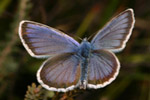
Silver Studded Blue
A butterfly of the dry heath land where heather plants grow. For it is on these plants that the female, will lay her eggs. It is on the wing from June to September. It is the most abundant butterfly found on Slop Bog. Look for it on any heather covered area.

Speckled Wood
Is a butterfly of shady lanes and open clearings in woods where the sun filters through the trees. It is on the wing from April to the end of September. Feeds mainly out of sight drinking honeydew on treetops. Will also feed on bramble blossoms. At Slop Bog it is fairly common along the edge of Hazel Wood, along Kingfisher Creek and in Wet Wood.
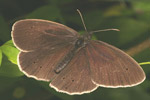
Ringlet
The Ringlet has a velvety appearance and is dark brown to almost black, with a white fringe to the wings. Small ringed circles on the underwings vary in number and size. Preferring damp conditions in partial shade such as tall grasslands and woodland glades. Egg laying takes place on several varieties of grasses Cock’s-foot, Tufted Hair-grass, Common Couch and meadow-grasses.
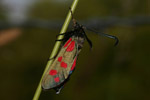
Six Spot Burnet Moth
Found in grassy areas, this distinctive day-flying red and black moth indicates its poisonous taste to other creatures. The caterpillars feed on wild flowers such as bird’s foot trefoil and clover and eventually create a yellow cocoon being spun high up on grass stems emerging in June / July.
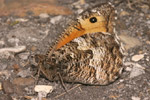
Grayling
This is a shy fast flying butterfly. When at rest it becomes almost invisible. It is to be found on dry heaths, and in grassy places. It is on the wing in July and August. On Slop Bog look for it on the open heath land, especially along the pathways cutting across the heath.
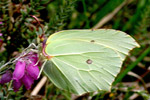
Brimstone
Awakes from its winters hibernation on warm sunny spring days. It may be seen almost anywhere, as it is a very active butterfly, wandering through woods, and over the countryside. It is on the wing, from February, through to November. The female lays her eggs on buckthorn bushes. May be seen flying almost anywhere on Slop Bog.
Flora
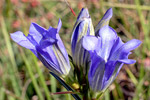
Marsh Gentian
A weak perennial, that grows on damp acid heaths. It is in flower from July to September and the flowers only open fully when the sun shines… About twenty or so flowering plants have been found on Slop Bog. Most on the damp areas on Western and Eastern Enclosures, The trumpet like flowers are a beautiful shade of blue.
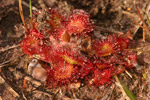
Sundew
A widespread insectivorous perennial of wet heaths and moors. The long narrow leaves which arise from the base catch various insects including dragonflies and damselflies. The leaves are covered with sticky red tipped gland-bearing hairs. Once an insect is caught the leaves absorb the soft parts of the insect. Found growing on sphagnum moss around acid ponds on Slop Bog.
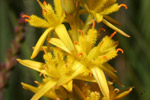
Bog Asphodel
Will grow in the wettest parts of the heath, usually in sphagnum moss. It flowers, from June to August. Sometimes, turning areas of the heath a bright yellow. After flowering, the fruits turn bright orange. Flowering spikes up to 15 cm. Look for them from the viewing platform on the boardwalk. From here you will see them around the edge of the acid pools.
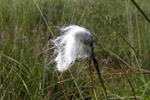
Cotton Grass
Favours boggy ground with peaty,acid soils. Locally common. The long conspicuous white cottony threads on the fruits makes the plant very conspicuous. At Slop Bog it grows around the acid pools near the boardwalk.
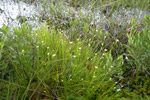
White Beaked Sedge
A perennial plant, of boggy wet heaths, on acid soils. In the South it is rather an uncommon plant. Look for the small yellowish /brown spikelets, between June and September.

Gorse
A very spiny evergreen shrub, common and widespread, usually on acid soils on heaths. Flowers for most of the year, but the bright yellow flowers are at their best from March to May.

Heather (Ling)
The main plant found growing on heaths and moors. It flowers from July to September, when it turns large areas of heath a bright reddish-purple. A closer look will reveal the real beauty of the small delicate flowers. At Slop Bog it grows mainly in Silver Studded Blue and Western Enclosures.
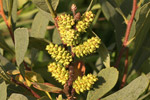
Bog Myrtle (Sweet Gale)
A deciduous bush growing up to four feet high. It has a strong fragrant resinous smell. The male catkins are long and orange in colour. Flowers from April to May. Locally common in Bogs, Fens, and wet places on heaths. The best place to see it at Slop Bog, is along the edge of the boardwalk.
Reptiles & Amphibians

Common Lizard
Emerges from hibernation in March and may be active until October. It favours heaths, moors and dry grassy places. It feeds on various insects such as grasshoppers, caterpillars and spiders. It is quite common all over Slop Bog. The best place to see them is on the boardwalk where they bask in the morning sunshine.
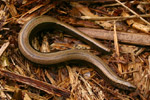
Slow Worm
Although Slow Worms may look like a snake, they are really lizards, which do not have limbs. They come out of hibernation in March and remain active until October. They live along hedgerow banks, heaths, and dry grassy places. They feed on insects, including worms. Fairly common on Slop Bog, best looked for early in the morning, They may be seen sunning themselves on the edge of pathways.
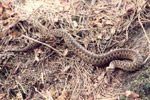
Adder/Viper
Our only poisonous snake, it will only attack to defend itself. It is the most widely distributed of our three native snakes. They feed on small mammals, nestlings, and lizards. It is to be found on heaths, moors, and woodland rides. Emerges from hibernation in March and is active until October. Only a few are seen each year at Slop Bog. You are most likely to see one sunning its self on the pathways across the heath.
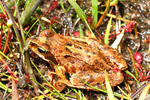
Common Frog
Common and widespread. Visits ponds and lakes to breed. Feeds on insects, worms, and spiders. At Slop Bog, they can be seen spawning in February and March. Look for them in the ponds in front of the viewing platform on the boardwalk.
Birds
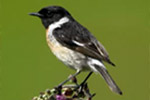
Stonechat
It is a resident and breeds on heaths, and commons, especially where there is plenty of gorse. Has a harsh call, like two pebbles being knocked together. One or two pairs have nested on Slop Bog most years. Look for them calling from the tops of trees, and on gorse on the open heath.

Dartford Warbler
The Dartford Warbler Is a resident on heaths in the South of England. It is a rather shy secretive bird, usually keeping well hidden in gorse bushes or other thick vegetation. Occasionally it can be seen perched on top of gorse bushes. At least one pair has nested on Slop Bog and raised young.

Nightjar
Nightjars arrive in this country in late April and usually nest on heaths, often near trees. Hunts for moths and other insects just after dusk or before dawn. It is best to listen for its long churring call at dusk. Has been heard and seen at Slop Bog, usually along the edge of the pines.

Snipe
The Snipe breeds in damp meadows, marshes, and bogs. Has a noisy drumming display flight, which is usually performed early in the morning. At Slop Bog, it is only a winter visitor where it has been seen near the boardwalk and on paths across the heath when they are covered with water.

Greater Spotted Woodpecker
The Greater Spotted Woodpecker has a black and white plumage, red rump with the male also displaying a red nape. Feeds on ants and the larvae of wood boring beetles by rapidly pecking on the bark of trees. The distinctive drumming sound can be heard from quite a distance.
Funghi
-
This list is the result of a series of four Slop Bog Fungi Walks led by George and Audrey Dunkling between 20 – 29 October 2006. Sixty nine species of fungi were identified. Latin names and English names are shown, where known.Agaricus Langei – Scaly Wood Mushroom
Amanita Muscaria – Fly Agaric
Amanita Rubescens – The Blusher
Amanita Patherina – Panther Cap
Amanita Citrrina – False Death Cap
Boletus Badius – Bay Boletus
Boletus Chrysenteron – Red-Cracked Boletus
Boletus Edulis – Cep or Penny Bun
Boletus Luteus – Slippery Jack
Boletus Scabrum – Brown Birch Bolete
Boletus Versipelle – Orange Birch Bolete
Calocera Viscosa – Yellow Stags Horn
Clavulina Cinerea – Grey Coral Fungus
Clitocybe Geotropa – Trooping Funnel
Citocybe Gibba Infundibuliformis – Common Funnel Cap
Collybia Maculata – Spotted Tough-Shank
Coprinus Micaceus – Glistening Ink Cap
Coprinus Niveus – Snowy Ink Cap
Cortinarius Hinnuleus – Earthy Webcap
CortinariusPalaeceus – Pelargonium Webcap
Crepidotus Mollis – Soft Slipper
Crepidotus Variabillis – Variable Oysterling
Daedalea Quercina – Maze Gill
Daedaleopsis Confragosa – Blushing Bracket
Flammulina Velutipes – Velvet Shank
Fomes Fomentarius – Hoof Fungus
Geastrum Triplex – Collared Earth Star
Hebeloma Crustulinforme – Poison Pie
Hygroporopsis Aurantiaca – False Chanterelle
Hypholoma Fasciculare – Sulphur Tuft
Hypoxylon Fragiforme – Beech Woodwort
Inocybe Hirtella
Inonotus Hispidus – Shaggy Bracket
Laccaria Amethystina – Amethyst Deceiver
Laccaria Laccata – The Deceiver
Lactarius Deterrimus – False Saffron Milk Cap
Lactarius Hepaticus – Birch Milkcap
Lactarius Rufus– Rufous Milk Cap
Lactarius Turpis – Ugly Milk Cap
Lepiota Cristata – Stinking Parasol
Lycogala Terrestre – Wolf’s Milk
Lycoperdon Perlatum – Common Puffball
Marasmius Rotula – Collared Parachute
Mycena Filopes – Iodine Bonnet
Mycena Galopus – Milking Bonnet
Mycena Leptocephala – Nitrous Bonnet
Mycena Pura – Lilac Bonnet
Mycena Splendidipes – Yellowleg Bonnet
Panaeolus Semiovatus – Egghead Mottlegill
Paxillus Involutus – Brown Roll Cap
Phellinus Ignarius – Willow Bracket
Phlebia Merismoides
Pholiota Mutabilis – Sheathed Woodtuft
Pluteus Cervinus – Deer Shield
Polyporus Betulinus – Birch Polypore
Postia Caesia – Blue Cheese Polypore
Russula Atropurpurea – Blackish Purple Russula
Russula Cyanoxantha – Charcoal Burner
Russula Emetica – The Sickner
Russula Nigricans – Blackening Brittlegill
Russula Ochroleuca – Ochre Brittlegill
Russula Sardonia – Primrose Brittlegill
Russula Xerampelina – Crab Brittlegill or Shrimp Mushroom
Sclerderma Aurantium – Earth Ball
Stereum Hirsutum – Hairy Curtain Crust
Trametes Versicolor – Turkey Tail
Tremella Mesenterica – Yellow Brain Fungus
Tricholoma Rutilans – Plums and Custard
Xylaria Hypoxylon – Candle-Snuff Fungus -
There are many species of fungi, perhaps eight times as many as flowering plants in the UK so it is a huge task to learn them all. However, it is possible to get to know the different groups of fungi.Many fungi on Slop Bog fall into these various groups:-
Russula – Brittlegills. Many brightly coloured species with caps of red, yellow, purple, green or white. Brittle flesh easily falls to pieces.
Lactarius – Milkcap. Exude milk from gills and flesh when damaged. Flesh is brittle like Russulas so easily breaks up.
Mycena – Small bell shaped mushrooms usually with a long thin stem often found on rotten wood or leaf litter.
Clitocybe – Funnel caps, usually funnel shaped and some can be very large. Often have distinctive smell.
Laccaria – Deceivers As colour is often different when wet or dry and can look like any old small mushroom until you get your eye in to identify them. Usually on ground in woods or heath.
Tricholoma – Usually white or pale coloured gills medium sized. May have distinctive smell.
Marasmius – Parachute. Most are very small and occur on twigs and other debris. Tough and leathery.
Collybia – Toughshanks. Have tough flexible stems. Found on the ground in woodland.
Lepiota – Parasols. Distinctive elegant shape, have scales on the cap and rings on the stem. Gills white.
Amanita – All have volva or sack at the base of the stem and several have rings on the stem. Gills white.
Pluteus – Often singly on rotten wood. Can often see the tinge of pink spores on the gills.
Cortinarius – Webcaps. All have a web like cortina (which is easily rubbed off if you are not careful). Gills of various colours but tend to go brownish red when they release their spores.
Pholiota – Scalycaps. Most species yellowish and usually grow in clumps on stumps or branches.
Hebeloma – Poisonpie. Caps often slimy and dull cream coloured. Gills clay coloured.
Inocybe – Fibrecap. Cap often breaks up into radiating stripes as it dries out. Small dull coloured fungi often seen along tracks.
Hypholoma – Dull orange/yellow or fawn coloured often growing on stumps in clusters.
Agaricus – Generally look like the common cultivated mushroom you see in supermarkets but can have white, brown or scaly caps.
Coprinus – Inkcaps. Flimsy fungi that easily fall apart and rapidly deliquesce turning the gills into black ink.
Boletus – Has tubes below the cap instead of gills. Most are rather large or meaty.
Geastrum – Earth Stars. Ball surrounded by star shaped structure that opens.
Tricholomopsis – Plum coloured cap and stem, custard coloured gills. Grows on pine tree stumps.
Trametes – Turkeytail. Concentrically patterned grey-blue or grey-brown on deciduous wood.
Xylaria – Candlesnuff. Black at first turning white at the top. Found on dead wood.
Click on the link below to view George Dunkling’s photographs of various fungi species.
Our Resident Photographer

George Dunkling
View George’s extensive collection of wildlife photographs on Flickr by clicking here.








